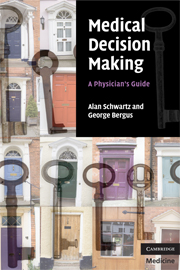Foreword
Published online by Cambridge University Press: 04 May 2010
Summary
This lucid, well-written book fills a distinct gap in the literature on decision making in the health professions, especially medicine and nursing. What is this gap? And how does this book address it?
Introductory presentations of medical decision making typically begin with how to assess the accuracy of clinical evidence, especially diagnostic tests, and move on to drawing inferences. Making diagnostic judgments is conceptualized as a problem of updating opinion with imperfect information, and Bayes's theorem is the method to solve the problem. Probability and uncertainty are highlighted and Bayes's theorem is presented in one form or another. Other books are intended as graduate texts for health professionals who wish to practice decision analysis or do research using statistical decision theory. This book is positioned somewhere between those two poles.
Instead of starting with diagnostic testing, it begins with the problem of determining goals and objectives of medical care and with methods for assessing values and the quality of life. It does not neglect probability, uncertainty and how they can be effectively discussed with patients, but it puts values, utility assessment and choice on center stage. Interestingly, it does not get to Bayes' theorem and diagnostic testing until better than halfway through the text. By that time, the reader should have a very good idea of how concepts and principles of medical decision making extend well beyond the setting of diagnosis with which the field arguably began.
- Type
- Chapter
- Information
- Medical Decision MakingA Physician's Guide, pp. xi - xiiPublisher: Cambridge University PressPrint publication year: 2008

